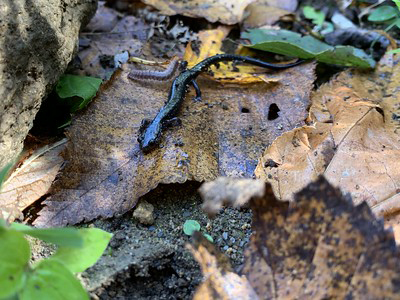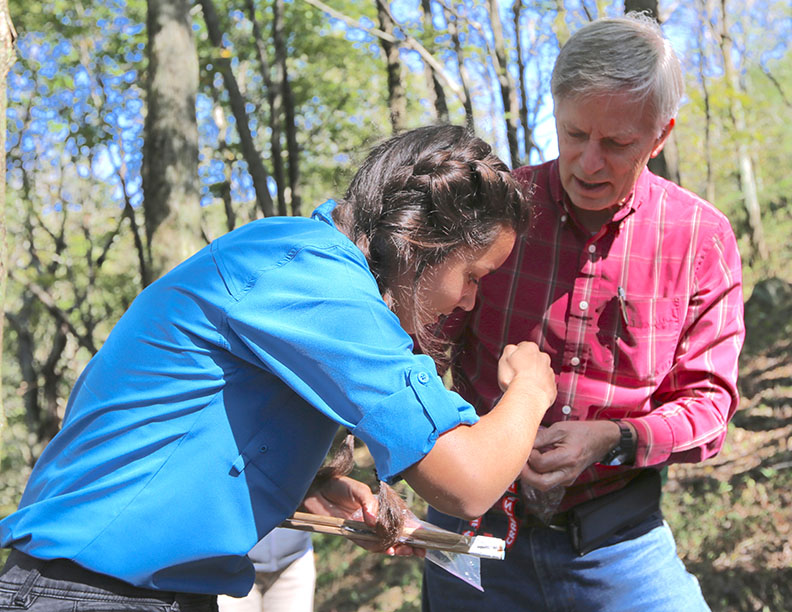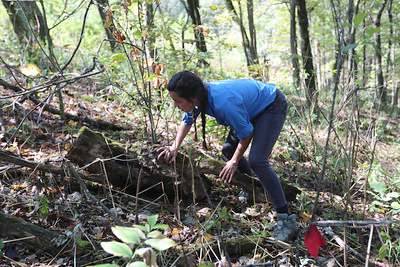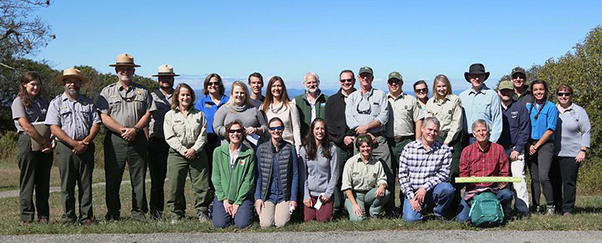Search News Archives
Filter News Articles
Additional Navigation
National agencies recognize research team’s efforts to conserve salamander species
December 10, 2019 : By Office of Communications & Public Engagement

This fall, in the shadow of the Peaks of Otter in the Blue Ridge Mountains near Bedford, Va., a somewhat unconventional celebration was held. A number of animals in the Blue Ridge are on the Endangered Species list, but thanks to a joint conservation effort that involves Liberty University and state and federal agencies, the Peaks of Otter Salamander was formally recognized as a species that won’t be wiggling its way into that group.
The salamander is only found in a 45-square-mile area, primarily between the middle of Flat-Top Mountain and Apple Orchard Mountain, where mature hardwood forests above 1600 feet elevation create the ideal habitat to support this salamander. It was here in this habitat that representatives from the U.S. Fish and Wildlife Service (USFWS), National Park Service (NPS), U.S. Forest Service (USFS) and students and faculty from Liberty met on Oct. 9 to celebrate the 5-inch amphibian.
Drs. Norman Reichenbach and Paul Sattler, biology professors in the Department of Biology & Chemistry have involved their undergraduate students in the salamander study since the early 1990s.

“We teach our students all sorts of interesting things about ecology and molecular biology, and with the work we’re doing on the Peaks of Otter Salamander, we actually get them out of the classroom to apply this knowledge in the field. Through their work, our students are actually contributing to the conservation of a species.”
He explained that the Peaks of Otter salamander worldwide distribution is in a 12-mile stretch of Virginia forest adjacent to the Blue Ridge Parkway. And although human interface is often the reason why a species may become endangered, the conservation studies conducted by the team revealed another factor as well. In a study which began in 2005, it was discovered that the Eastern Redbacked salamander (commonly found throughout the Eastern and Northeastern United States) competes with the Peaks of Otter Salamander. Unless the habitat is carefully managed, this competing species could encroach on the fragile habitat of the Peaks of Otter salamander, thus endangering the future of this species.
“The big thing was figuring out what’s causing this animal to be boxed in and have such a restricted distribution,” Reichenbach said. “We need to carefully manage the perimeter of its habitat. As owners of the land where the Peaks of Otter salamander lives, the USFWS, NPS and USFS understand that, and we are working jointly to ensure that the forest canopy is kept intact in the perimeter areas so that we don’t create conditions that would favor Eastern Redbacked salamander population growth and range expansion to the detriment of the Peaks of Otter salamander.
Reichenbach believes that this partnership has been a win-win situation in that it allowed him and his team to conduct ecological research on this species which in turn has assisted these organizations in the conservation of this species.

Reichenbach points to the stewardship role from Genesis 2 — the charge to care for God’s creation — that unites the team in its efforts. Whether the effort is an act of maintaining biodiversity or honoring God’s creation, the outcome has created a greater understanding of the Peaks of Otter Salamander, particularly how and where it needs to be managed to ensure that it continues to thrive.
Wendi Weber, U.S. Fish and Wildlife Service North Atlantic-Appalachian Regional Director agrees. “By building relationships across federal and state agencies, with landowners and land managers, with universities and organizations, we can achieve much more than we can alone. Successful partnerships like this one are built when we can gather around the table and understand one another’s goals and needs. With the right people, resources and mindset, we can find solutions that keep these public lands working and conserve at-risk wildlife and their habitats.”
“It’s been fun having a bunch of people up here that love salamanders,” added Reichenbach. “We get to do some cool research and I feel like God has placed this little salamander in our backyard basically. It’s a blessing from the Lord that we’ve been able to engage a large number of undergraduate students who have been blessed equally in being able to do field research on this animal.”
In addition to Reichenbach and Sattler, Dr. Matt Becker is part of a team of Liberty biology faculty who have participated in these studies. Drs. Timothy Brophy and Cory Goff participated in the Peaks of Otter Salamander studies as LU undergraduate students and now, as current LU biology faculty, are continuing in this conservation work. The collaborative work on the Peaks of Otter salamander has resulted in seven oral presentations, eight poster presentations, four Liberty undergraduate honors theses, and seven publications in scientific journals. Most of the presentations and publications have been co-authored by Liberty undergraduate biology students. Students and faculty from Washington and Lee University and Virginia Tech are also members of the research team.



